

Tony Heaton: altered
Attenborough Arts Centre, Lancaster Road, Leicester LE1 7HA 24 March – 25 June 2023, Gallery 1
A major solo exhibition by British sculptor and disability rights activist, ‘altered’ produces intelligent and thought-provoking work that is a reflection of the artist’s own lived experience as a disabled person.
OUT OF ORDER
A performance and film by Tony Heaton and Terry Smith
BALTIC Gateshead 2 July 2022
Made as part of WAIWAV www.dasharts.org
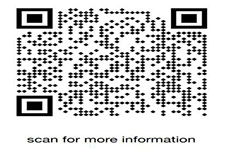
WHITE ON WHITE
Barbara, Johnny and the Quiet Revolution' 2002 Mixed Media
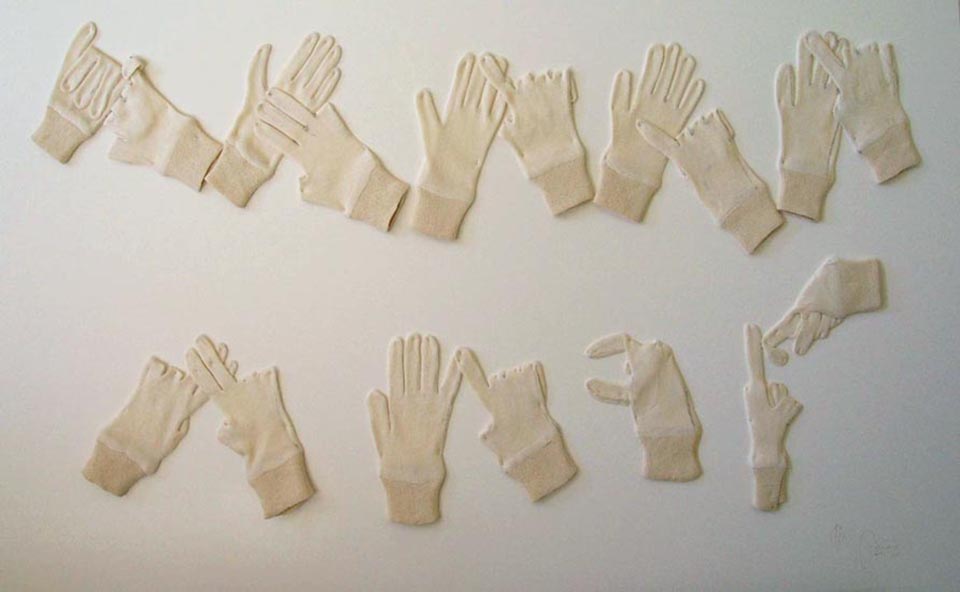
Concerns language. The language of art and BSL (British Sign Language). Next to English, the language I use and need most, but not offered as part of my compulsory state education that forced oral and European options only. The starting point for the work was buried in my subconscious, from poetry and time past. C'est la vie.
Tony Heaton entitled his picture White on White, thus playing with the ambiguity of the titles of many modernist works of art. But it's subtitle: Barbara, Johnny and the Quiet Revolution told a more melodramatic tale. Johnny Crescendo and his partner, stage-named Wanda Barbara, were the main acts for a Disability Arts Cabaret at a "special" school. Johnny has a rock and roller's prediliction for not just volume but raw language. The non-disabled organisers taste was for censorship. So he simply pulled the plug on the amplifier.
In response to the paternalistic way many people in institutionalised settings are treated, Johnny and Barbara circulated a poem. It's message was that disabled people were allowed to say thank you to mainstream performers who were allowed to entertain them with their charity, but were not allowed to express a contrary view. Each verse concluding "but they do"! Tony's reference to a "quiet revolution" was that only in 2003 was sign language been recognised as an official language! In this artwork the top line of arts conservators' white gloves spell "smile". But to read the bottom line you will need to find a BSL user.

From Paddy Masefield Strength: Broadsides from Disability on the Arts pg 122-123
Trentham Books Ltd
(United Kingdom), 2006
ISBN: 9781858563800
ISBN-10: 1858563801
SPRINGBACK
This work has been described as a self-portrait. It is an assemblage of my spinal X-ray and the stainless steel springs inserted by surgeons, following a motor cycle accident. The interlocked springs are from the suspension system of a motor cycle. The work is about a return to life.
image by Paul Kenny
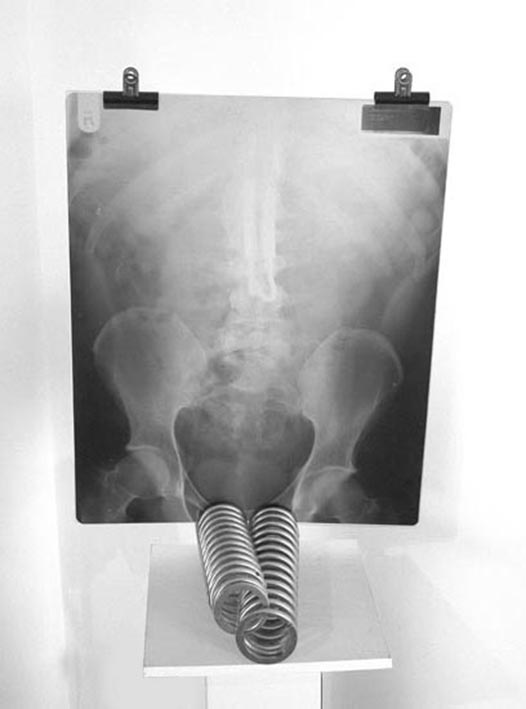
WHEELCHAIR ENTRANCE
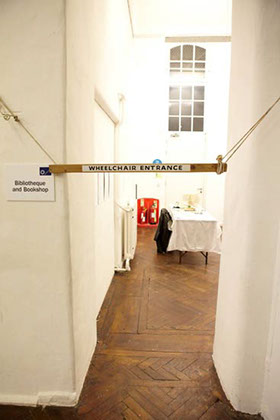
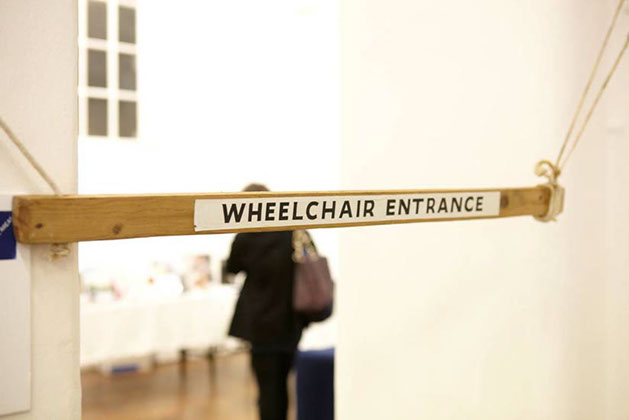
‘Wheelchair Entrance’ sculpture/Intervention (1989) – timber 28”x2”x1” lettered with the words, ‘Wheelchair Entrance’ with two hanging ropes. The piece is designed to hang in a doorway at a height that will impede ambulant people but give clear access underneath it to wheelchair users.
RASPBERRY RIPPLE
CLICK HERE to see the Light Projection, commissioned for Lumiere London light Festival – Southbank Centre London
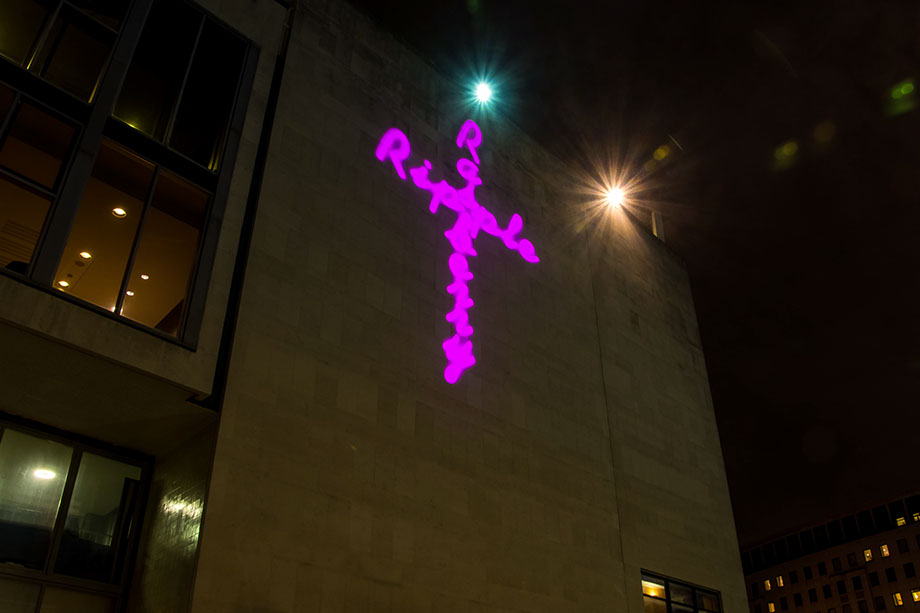
Photo by Astrid Eckstein
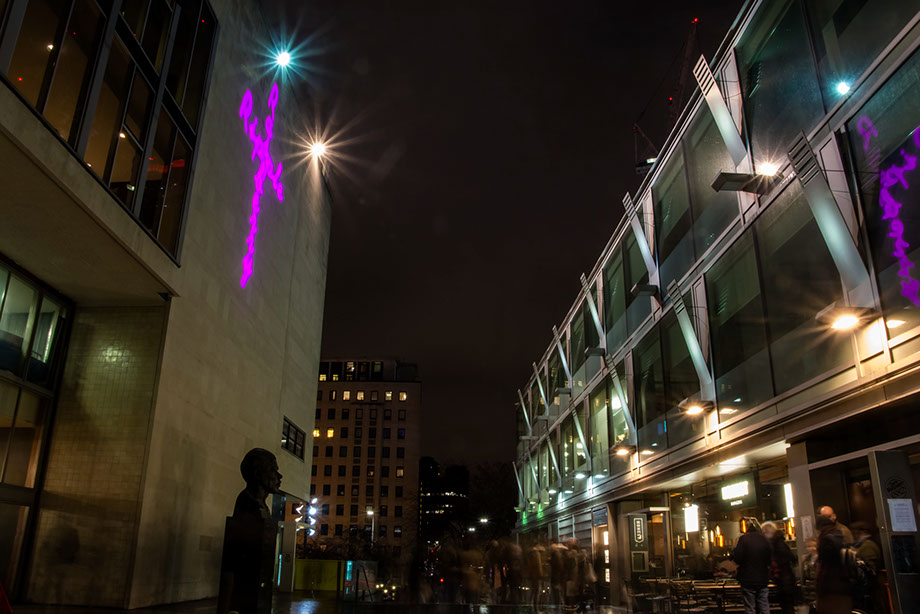
Photo by Astrid Eckstein
RASPBERRY RIPPLE - PINK NEON
Pink neon in a playful typescript can be superficially read as a fun image, reminiscent of ice cream, sweet and fruity, sexy even.
There is a deficit, the letter P is missing from the vertical word, Raspberry, it’s a silent letter, the horizontal word Ripple already has two letter P’s, it could be considered that three is a crowd.
The form is a cross, a rood. It’s not a crucifix but there is a sacrifice of sorts.
Raspberry Ripple…is rhyming slang for Cripple, we cripples resurrect it in Crip culture and Crip humour, it’s ours to own.
Words do oppress, words like Cripple and Queer.
Like the N word, forbidden and is thus imbued with its own power.
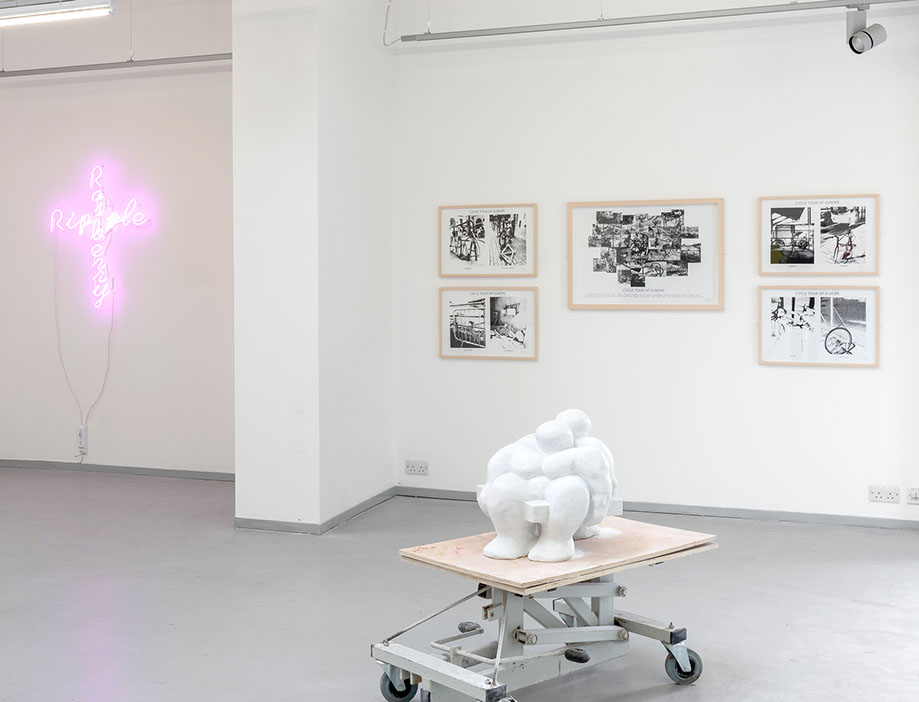
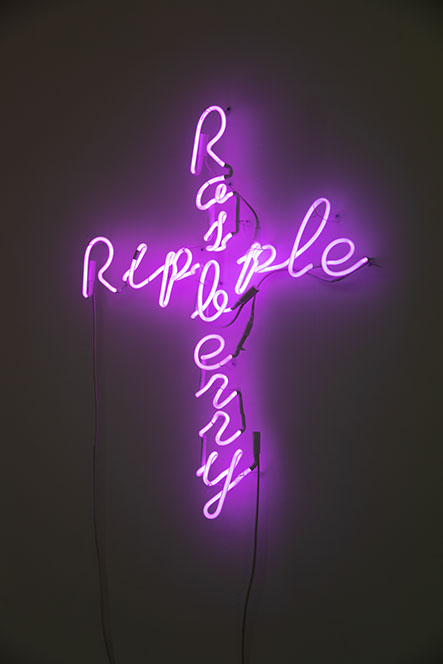
Photo by Jules Lister - The Art House
A BIGGER RIPPLE
A Bigger Ripple, Tony Heaton.
Lumiere Durham 2021, produced by Artichoke
Photo - Matthew Andrews
Neon 200 x 160cm
BREATHE NOTHING OF SLAUGHTER
Does it Matter?
Does it matter? - losing your legs? ...
For people will always be kind,
And you need not show that you mind
When the others come in after hunting
To gobble their muffins and eggs.
Does it matter? - losing your sight? ...
There’s such splendid work for the blind;
And people will always be kind,
As you sit on the terrace remembering
And turning your face to the light.
Do they matter? - those dreams from the pit? ...
You can drink and forget and be glad,
And people won’t say that you’re mad;
For they’ll know you’ve fought for your country
And no one will worry a bit.
Siegfried Sassoon (1917)

TRAGIC/BRAVE - NEON 2019
The polarity of the words tragic and brave have resonated throughout the disability community, and reference the fact that we are either seen as ‘brave’, in coming to terms with our impairments or conquering barriers, being Paralympians - or ‘tragic’, in need of care and control, pitiable or benefits scroungers. This paradox is played out in neon and cruciform.
Photo Credit: Richard Wheater – Neon Workshops
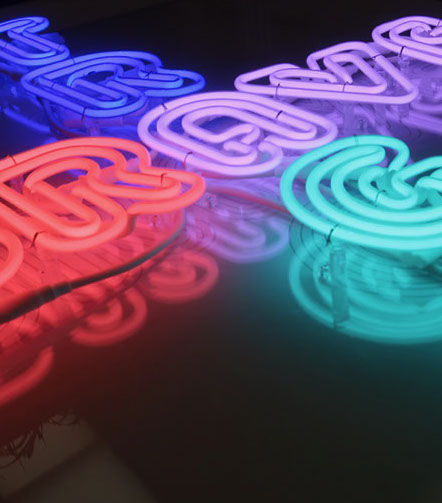
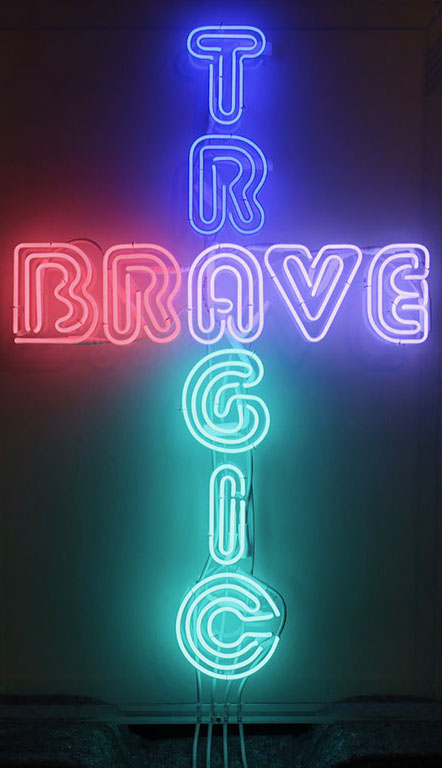
I examine the potent symbol of the war memorial and the reality of war. Heroic, Adonis-like bodies are set in stark contrast to images of blackened faces and malnourished and broken bodies.
In this series of short films, five contemporary disabled artists present warm, witty and poignant perspectives on war and disability.
From a cast of animated disabled soldiers to a chaotic WW1 hospital and the heroic figures depicted on war memorials, these films offer unorthodox, irreverent and unexpected takes on the legacies of war and disability in Britain today, taking inspiration from Siegfried Sassoon’s 1917 poem Does It Matter?
The war memorial, a potent symbol, often heroic, enduring, Adonis-like bodies waving flags or in prayerful repose, in glory. These
sculptural objects hold a prominent place in our civic life and act as a collective public memory.
The reality, malnourished bodies, broken, faces blackened, feet rotting, limbs protruding from bomb shattered earth, horrific, grotesque. This film explores the detail of the memorial, intercut with photographs of soldiers on the front, including the fallen and those disabled by the devastating effects of war.
“The sculptor has endeavoured to conceive a memorial that shall breathe nothing of slaughter, but only of duty fulfilled.” Pamphlet on the unveiling of the Burnley War Memorial, 1926.
SHAKEN NOT STIRRED
Original performance piece 1992.
Click HERE for the original performance images and article on Disability Arts Online
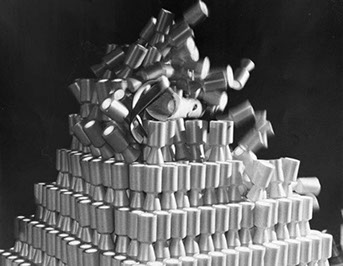
Jhinuk Sarkar
P45 performance
Credit: Sara Dziadik
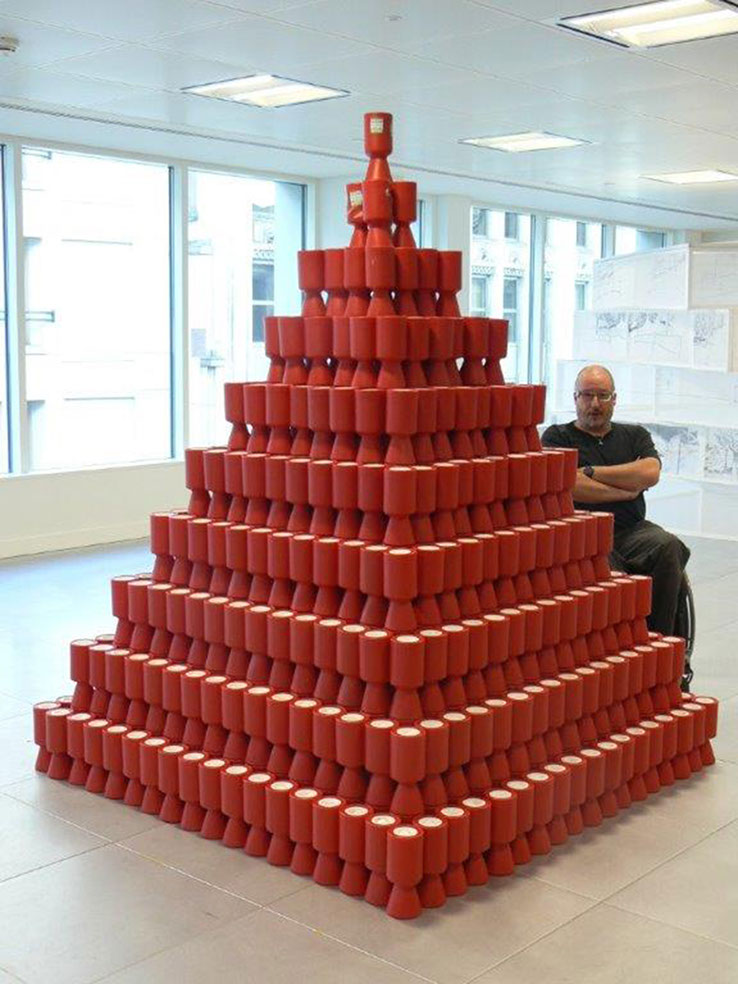
More specifically though, there was anger at the televisual device of what the protestors dubbed ‘show-us-your-stumps voyeurism’: the more pathetic and needy that disabled individuals were portrayed, the greater the public donations. In the build up to the 1992 Telethon, the Press had sensed the strength of disabled people’s anger and the possibility of (newsworthy) unrest. Hence the ‘Block Telethon’ Press Conference organised by the London Disability Arts Forum at the Diorama was well-attended by TV and newspaper journalists. In the centre of the conference room was Tony Heaton’s sculpture Shaken Not Stirred consisting in a pyramid formed from 1,683 charity collecting cans (1). The performance was a brief, shock-intervention into the conference as Heaton swiftly entered the room in his wheel chair carrying a prosthetic false-leg wearing a ‘bovver boot’. Swinging the ‘leg’ overhead he flung it into the pyramid to send the cans crashing to the ground before immediately leaving the room again. In an article published after the event (‘Versus’ magazine, Jan- April1994), Heaton elaborates upon the piece’s form, outlining that its geometric design of a pyramid was intended to echo the hierarchical structures of (non-disabled led) charities. Further, the title Shaken Not Stirred reflects the essentially superficial act of assuaging one’s
guilt/sense of superiority, by ‘giving’ to disabled people through charity appeals rather than through social justice and rights. Heaton asserts that the typical couch-potato Telethoner isn’t stirred to any meaningful action even if s/he is ‘shaken’ by the supposedly harrowing images of begging and drooling crips. A short film of Heaton’s performance was shown on Channel 4 and photographs of it were published in The Observer (see article here) (July 12th 1992).Around 2000 protestors circled the LWT building on the South Bank whilst the 1992 telethon was underway and a few people infiltrated the studio to shout slogans (‘Rights Not Charity’, ‘Piss On Pity’ etc) at the show’s compere, Michael Aspel. The 1992 ITV Telethon was the last one.
Note:(1) An interesting, ironic aside is that, having located a manufacturer of disability collecting cans, Heaton was not able to persuade the firm to charitably donate so many of them to his sculpture. It was only through the provision of an Arts Council grant (i.e. legitimate or‘ meretricious’ social funding) that he was able to purchase the cans -with no charitable discount – for £2,000.
LADA (Live Art Development Agency) study room guides by Aaron Williamson has an article on my 'Shaken not stirred' performance piece.
click here for the STUDY ROOM GUIDE
Here is the extract from the website -
Photo: Elspeth Morrison
Diorama Arts Centre, London, 1992 This was a protest performance staged at a press conference designed to register disabled people’s opposition to ITV’s charity Telethon. There were three ITV Telethons: in 1988, 1990 and 1992 each taking over the entire network for more than 24 hours and raising many millions of pounds through phoned-in credit card donations. By the time of the1992 Telethon an umbrella organisation ‘Block Telethon’ had been formed by over eighty disability groups. The main thrust of the protest was that disabled people need social rights rather than charity.
RO-TATE PERFORMANCE
This is a performance piece called 'Ro-Tate' performed in the Turbine Hall in Tate Modern as part of Architecture InsideOut. I asked 100 people to go from the top to the bottom of the ramp in the Turbine hall by any means other than walking.
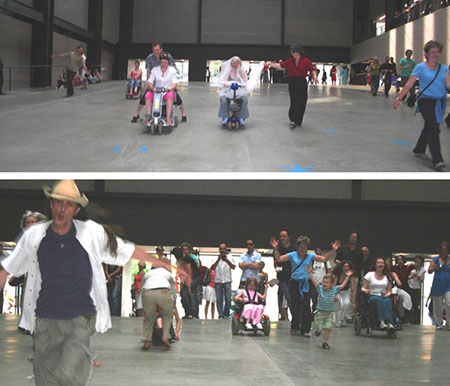
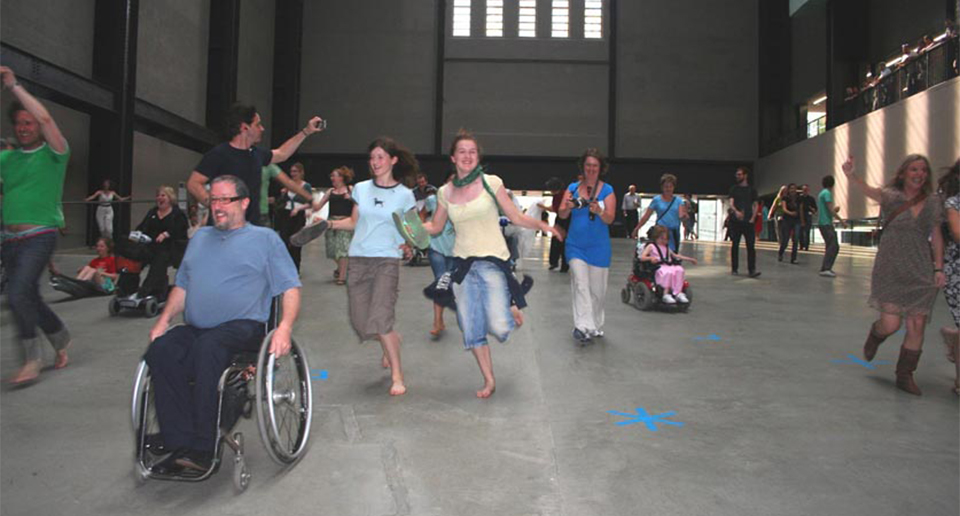
Princess Victoria surfs the yellow brick road - 2016
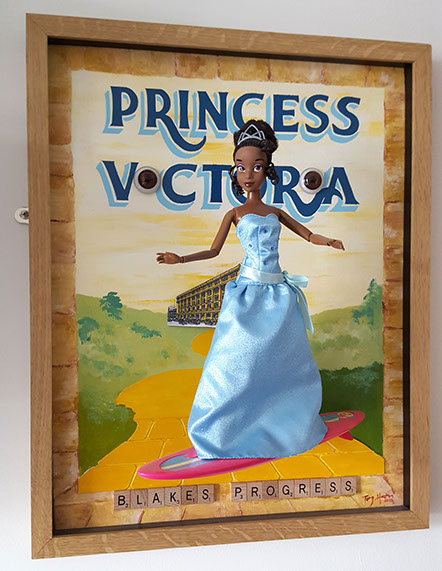
Mixed media - enamel on board, glass eyes, Princess Tiana doll, surfboard, wooden tiles, card.
This work is a commissioned piece by Graeae Theatre.
Reframing the Myth brought together creative people from different spheres to create new works of visual art.
I was commissioned to interpret the answers the classical singer Victoria Oruwari gave to a set of provocative questions posed by Graeae…
I wanted to replace the letter ‘I’s in the word Victoria with glass eyes, I was worried about her thinking that this bit of subversion would be offensive but she laughed loudly!
It was also important to have tactile elements within the piece.
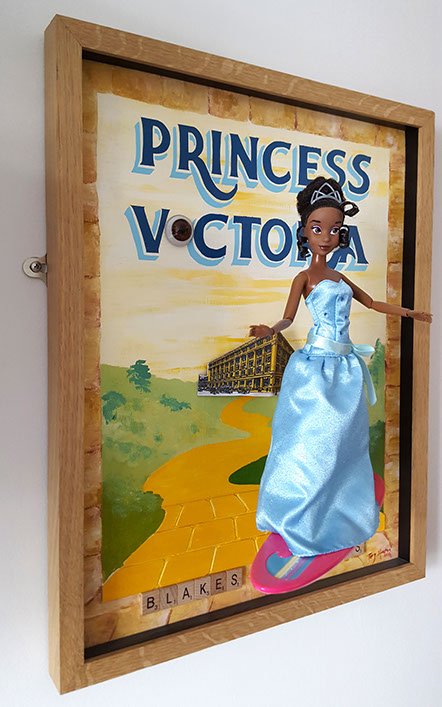
`I'm a versatile classical singer, songwriter, teacher of singing and actor who happens to be blind. I'm perceptive with a great capacity for empathy and I like to treat people the way I would like to be treated. I first heard about Graeae when I left school, my first Graeae experience was my audition for The Threepenny Opera when I was lucky to get the role of `Mrs Peachum', it was a really positive experience.' Victoria Oruwari
`Victoria said that when she grew up she wanted to be a princess. The work had to reflect the musical (or music) which is Victoria's passion. So I turned the super highway into the yellow brick road from The Wizard of Oz musical... protruding from the bottom right is a Princess Tiana doll on a surfboard. I also referenced the opera The Rakes Progress but I changed it using scrabble tiles from Rakes Progress into Blake's Progress, which is also my nod to Peter Blake's work.' Tony Heaton
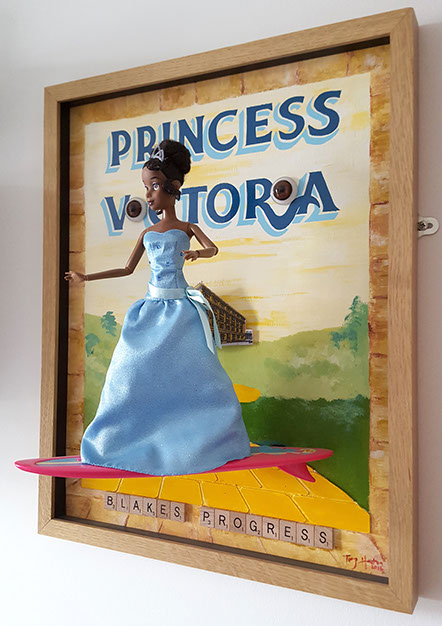
VA16 : ACCESS ALL AREAS
'The Barriers' An Intervention at the 15th International Architecture Exhibition, Venice - Venice Agendas
Images: Chelsey Browne
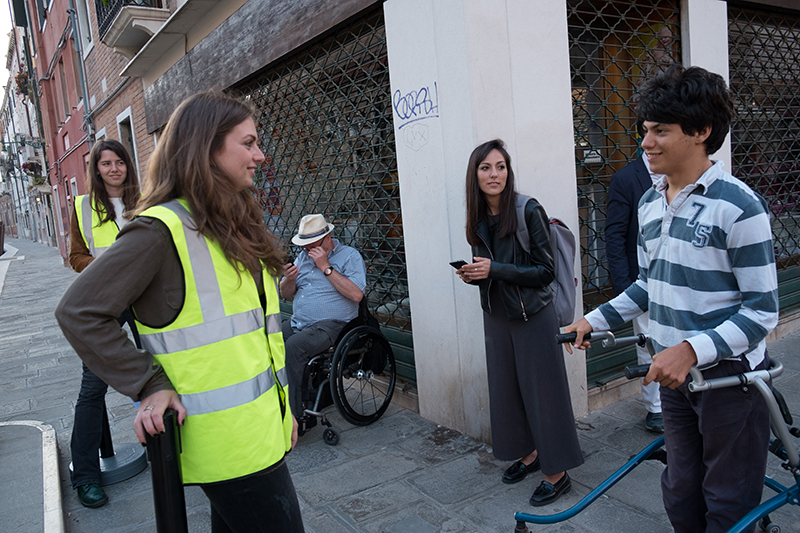
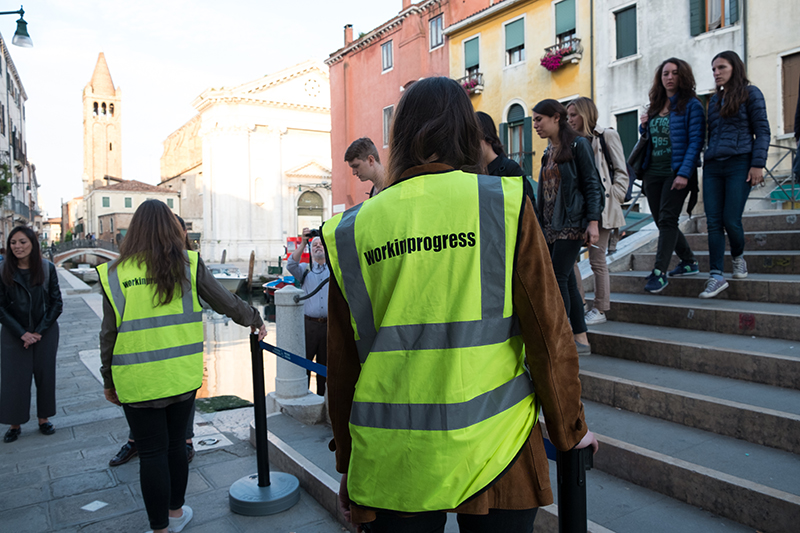
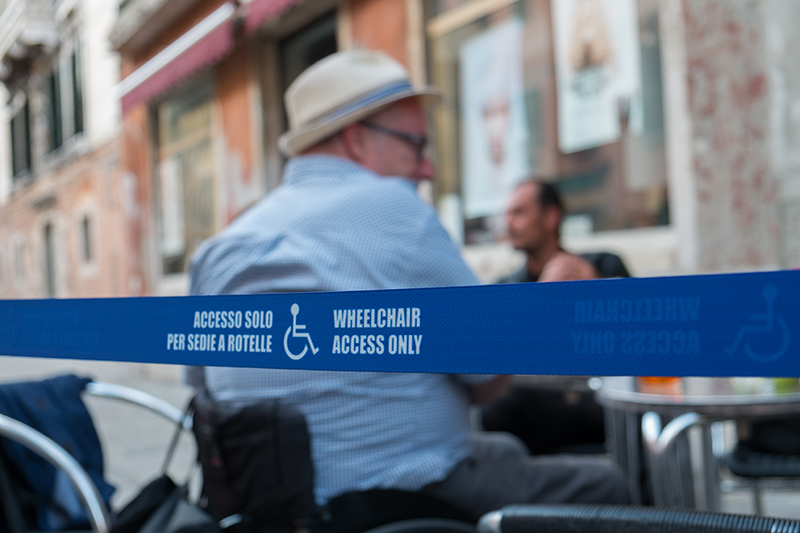
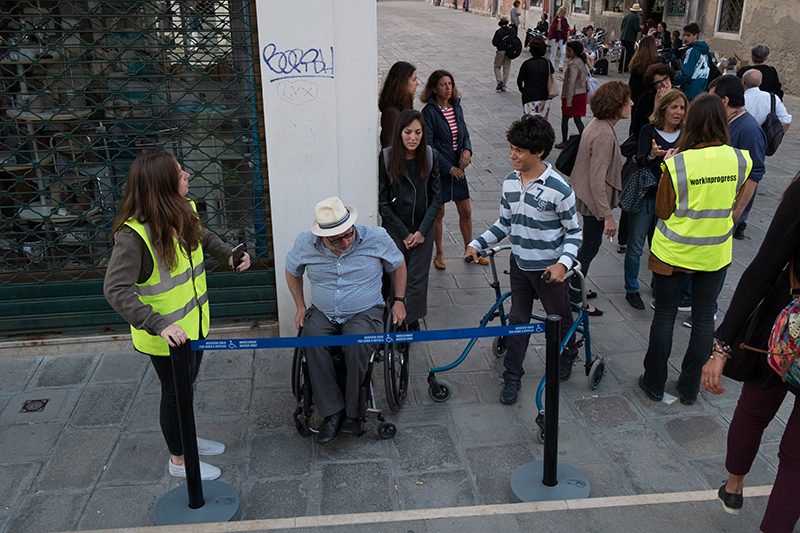
<
>
THE CONTRACT - THE BARRIERS
'The Barriers' An Intervention at Turner Contemporary VA2017
Images: Chelsey Browne
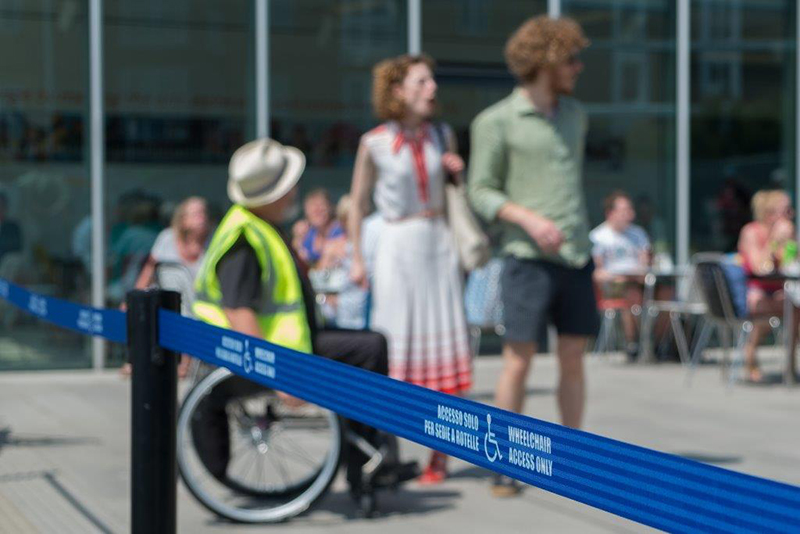
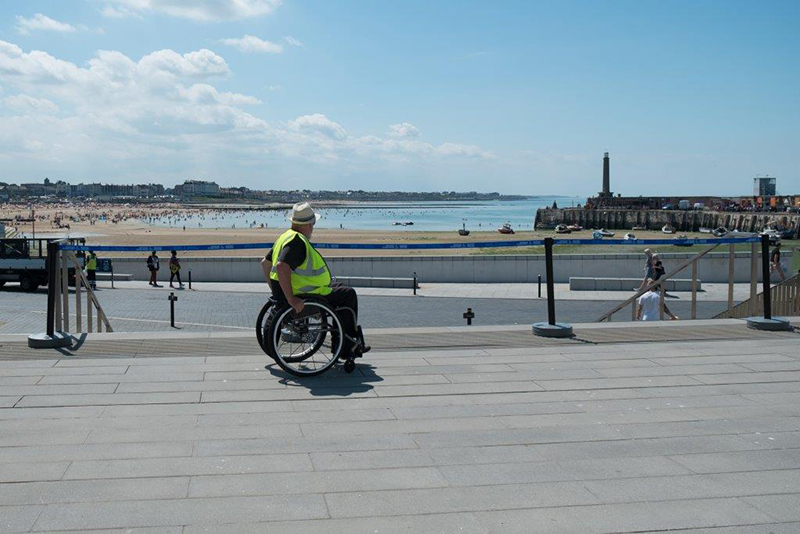
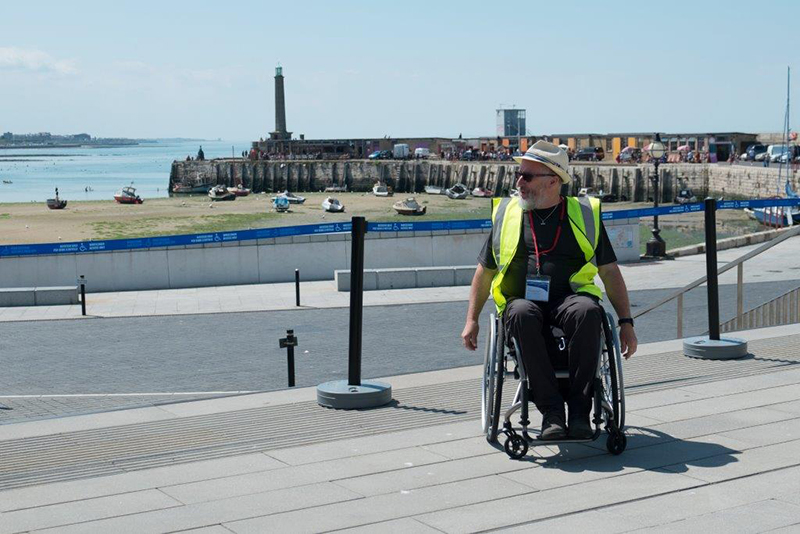
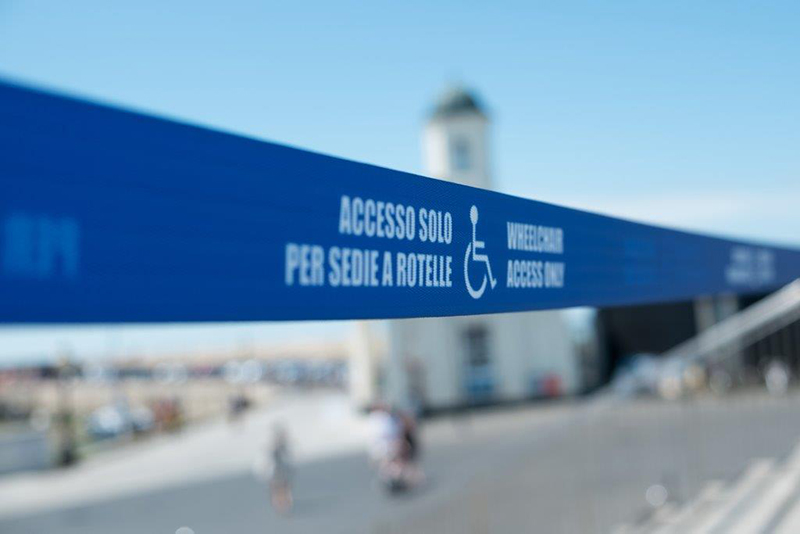
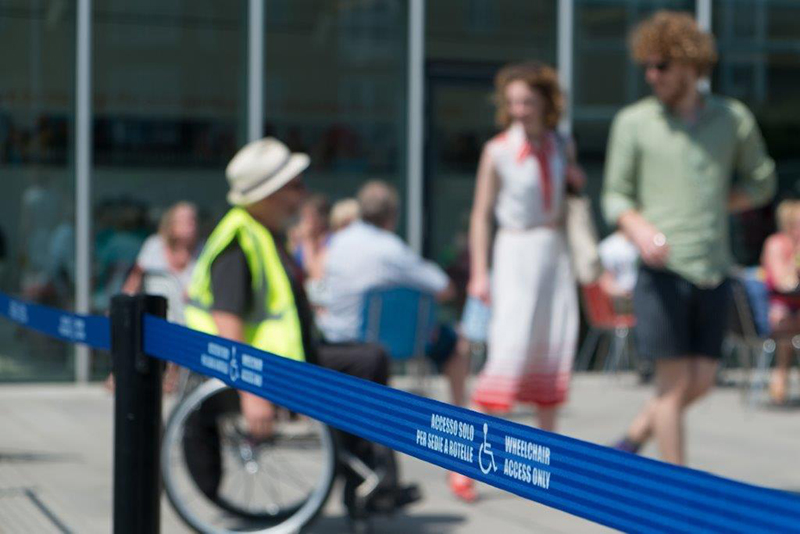
<
>
WHEELCHAIR ASCENDING AND DESCENDING A STAIRCASE
(after duchamp)
Performance. Tate Modern Turbine Hall.
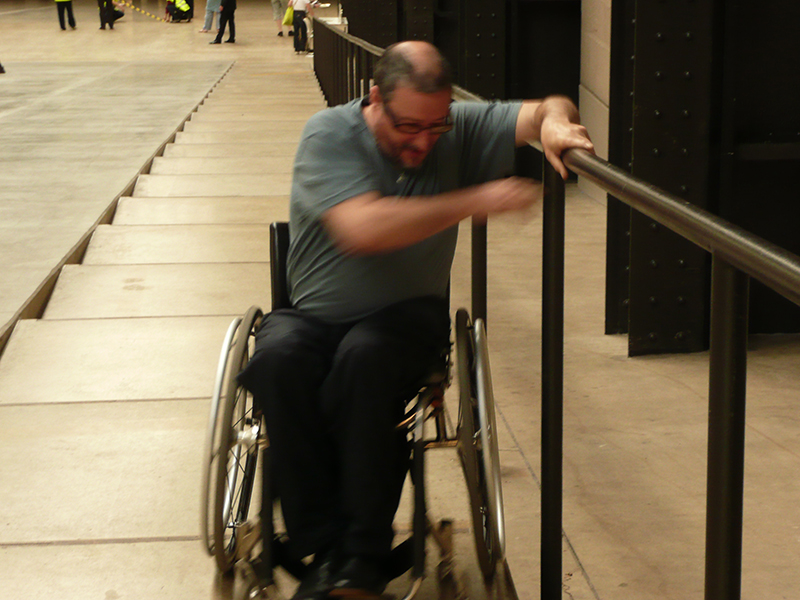
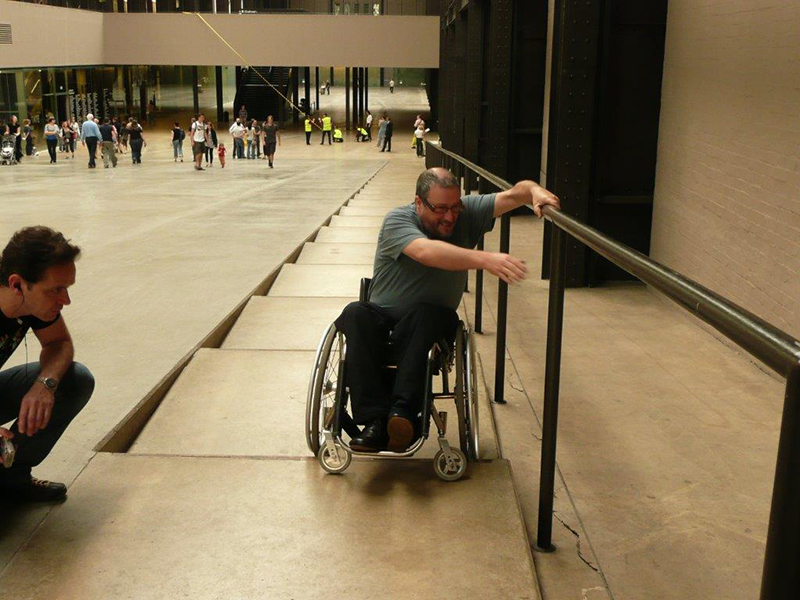
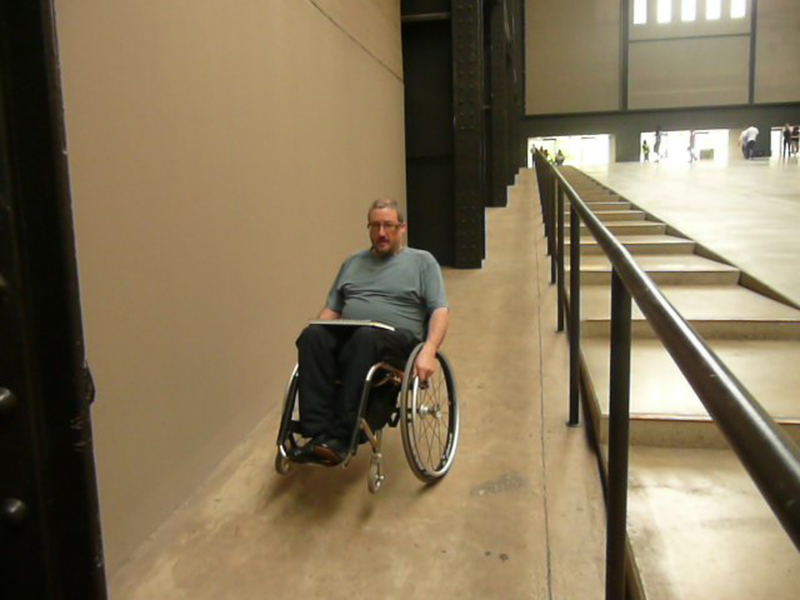
<
>